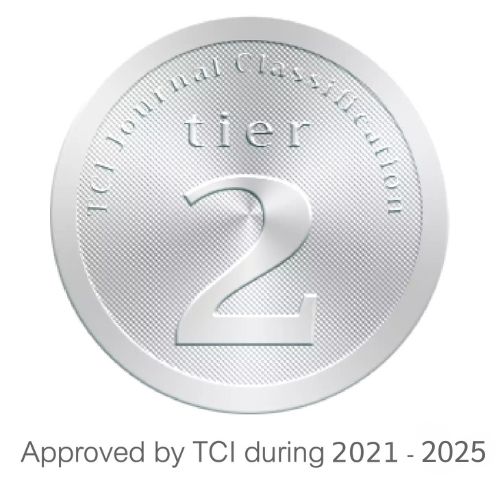การวิเคราะห์ปัจจัยบริบททางกายภาพที่มีผลต่อการสร้างทุน ทางสังคมภายใต้การพัฒนาอย่างยั่งยืน
Physical Context Factor Analysis Influences on Social Capital Under Sustainable Development
Keywords:
ทุนทางสังคม, การพัฒนาเมืองอย่างยั่งยืน , การวางแผนเมืองAbstract
พลวัตของการพัฒนาเมืองในมิติต่างๆ ส่งผลต่อการเปลี่ยนแปลงทางด้านสภาพแวดล้อมทางกายภาพของเมือง ทั้งรูปแบบการเดินทาง รูปแบบการอยู่อาศัย ตลอดจนรูปแบบทางสังคม มีผลต่อกลไกของการวางแผนเมือง และปัจจุบันด้วยการขยายตัวของเมือง จึงทำให้พื้นที่ในเขตเมืองขาดพื้นที่ปฏิสัมพันธ์ทางสังคม และขาดกิจกรรมที่ส่งเสริมการมีส่วนร่วม ดังนั้นการศึกษานี้มีวัตถุประสงค์เพื่อวิเคราะห์บริบททางกายภาพที่มีผลต่อการสร้างทุนทางสังคม โดยเก็บรวบรวมข้อมูลด้วยแบบสอบถามจำนวน 400 กลุ่มตัวอย่าง ในพื้นที่เทศบาลท่าโขลง จังหวัดปทุมธานี เพื่อสะท้อนปัจจัยเชิงสังคมและแสดงความแตกต่างของระดับทุนทางสังคม ด้วยวิธีการวิเคราะห์ความสัมพันธ์เชิงถดถอยโลจิสติกทวินามโดยสามารถจัดกลุ่มของปัจจัยด้านกายภาพ ได้แก่ การกระจายตัวของลักษณะอาคารต่าง ๆ ระยะการให้บริการของสาธารณูปโภคและสาธารณูปการตามระยะของการเข้าถึงทางถนน ปัจจัยด้านทุนทางสังคมแบ่งออกเป็น 6 ด้าน ได้แก่ (1) เครือข่ายทางสังคม (2) ความ พึงพอใจและความสุข (3) ความรู้สึกเป็นเจ้าของชุมชน (4) ความปลอดภัยในชุมชน (5) การเชื่อใจต่อเพื่อนบ้าน และ (6) การเชื่อใจต่อหัวหน้าชุมชน ผลการศึกษา พบว่า ลักษณะทางพื้นที่ที่แตกต่างกันส่งผลต่อการสร้างทุนทางสังคมที่แตกต่างกัน โดยพื้นที่ที่มีการใช้ประโยชน์ที่ดินประเภทแหล่งงาน ได้แก่ ชุมชนนิคมอุตสาหกรรมนวนคร ชุมชนบางขันธ์ จะเป็นพื้นที่ที่มีการรวมกลุ่มกิจกรรมมากมีผลต่อโอกาสในการสร้างทุนทางสังคมประเภทเครือข่าย ในขณะที่พื้นที่ชุมชนรอบมหาวิทยาลัยนั้นเป็นพื้นที่ที่มีโอกาสเกิดทุนทางสังคมประเภทความพึงพอใจและความสุขมากกว่าพื้นที่อื่นๆ อันถือเป็นปัจจัยเกื้อหนุนช่วยให้เกิดการพัฒนาอย่างยั่งยืนในอนาคตReferences
Aroonsrimorakot, S., & Vajaradul, Y. (2016). UN Sustainable Development Goals: 17 Aspects for Future World. Interdisciplinary Research Review. 11(3): 1–7.
Azmi, D. I., & Karim, H. A. (2012). Implications of Walkability Towards Promoting Sustainable Urban Neighbourhood. Procedia - Social and Behavioral Sciences. 50: 204–213.
Bourdieu, P. (1986). The forms of capital. In J. Richardson (Ed.) Handbook of Theory and Research for the Sociology of Education. (pp. 241-258). New York: Greenwood.
Coleman J. (1990). Foundations of Social Theory. Cambridge: Harvard University Press.
Davis, A. (2009). The Importance of Walkable Communities. Retrieved June 15, 2021, from https://travelwest.info/app/uploads/2020/05/11-the-importance-ofwalkable-communities.pdf.
Han, S. (2015). Social Capital and Subjective Happiness: Which Contexts Matter?. Journal of Happiness Studies. 16: 241–255.
Iamtrakul, P., & Chayphong, S. (2021). The Perception of Pathumthani Residents Toward Its Environmental Quality, Suburban Area of Thailand. Geographica Pannonica. 25(2): 136-148.
Iamtrakul, P., & Chayphong, S. (2023). Factors Affecting the Development of A Healthy City in Suburban Areas, Thailand. Journal of Urban Management. 12(3): 208-220.
Iamtrakul, P., & Raungratanaamporn, I. (2015). Sustainable Campus Town Development in Suburban Area of Bangkok, Thailand. International Journal of Building, Urban, Interior and Landscape Technology (BUILT). 6: 39-51.
Iamtrakul, P. Chayphong, S., & Lo, A.Y.W. (2022). Exploring the Contribution of Social and Economic Status Factors (SES) to the Development of Learning Cities (LC). Sustainability. 14(19): 12685.
Iamtrakul, P., Chayphong, S., & Raungratanaamporn, I. (2022). Exploring Different Level of Citizens’ Participation on Learning City Building. ICUE 2022 on Energy, Environment, and Climate Change, October 26 to 28 2022, Pattaya City, Thailand.
Iamtrakul, P., Chayphong, S., Pittipol, K., Yoshitsugu, H., Boonserm, K., & Yuji, I. (2023). Exploring the Spatial Effects of Built Environment on Quality of Life Related Transportation by Integrating GIS and Deep Learning Approaches. Sustainability.15(3): 2785.
Iamtrakul, P., Ruengratanaumporn, I., & Klaylee, J. (2018). The Impact of Urban Development on Social Capital in Urban Fringe Area of Bangkok, Thailand. Lowland Technology International (LTI) journal. 20(3): 341-350.
Ingram, G. K. (1998). Patterns of Metropolitan Development: What Have We Learned. Urban Studie. 35(7): 1019-1035.
Leyden, K. M. (2003). Social Capital and the Built Environment: the Importance of Walkable Neighborhoods. American Journal of Public Health. 93(9): 1546–1551.
Lin, N. (2001). Social Capital: A Theory of Social Structure and Action. Cambridge: Cambridge University Press.
Lin, N., & Bian, Y. (1991). Getting Ahead in Urban China. American Journal of Sociology. 97(3): 657-688.
Litchfield Whiting Bowne and Associates. (1990). Greater Bangkok Plan. 2nd ed. Bangkok: Department of town and Country Planning.
Office of the National Economics and Social Development Board. (2017). Nation Plan 20 Years (2017-2036) Bangkok. Retrieved June 15, 2021, from http://www.thaigov.go.th/.
Padon, A., Iamtrakul, P., Jintamethasawat, R., & Klaylee, J. (2022). Spatial Multicriteria Evaluation for Future Urban Growth in Bangkok Metropolitan Region: BMR. ICUE 2022 on Energy, Environment, and Climate Change, October 26 to 28 2022, Pattaya City, Thailand,
Portes, A., & Sensenbrenner, J. (1993). Embeddedness and Immigration: Notes on the Social Determinants of Economic Action. American Journal of Sociology. 98(6): 1320-1350.
Putnam, R., Leonardi, R., & Nonetti, R. (1993). Making Democracy Work: Civic Tradition in Modern Italy. Princeton. New Jersey: Princeton University Press.
Sassen, S. (1991). The Global City: New York, London, Tokyo. Princeton: Princeton University Press.
Wood, L., Shannon, T., Bulsara, M., Pikora, T., McCormack, G., & Giles-Corti, B. (2007). The Anatomy of the Safe and Social Suburb: an Exploratory Study of the Built Environment, Social Capital and Residents’ Perceptions of Safety. Health Place. 14(1): 15-31.
World Bank. (2001). World Development Report 2000/2001: Attacking Poverty. New York: Oxford. University Press.
Yamane, T. (1973). Statistics: An Introductory Analysis. 3rd ed. New York: Harper and Row.








